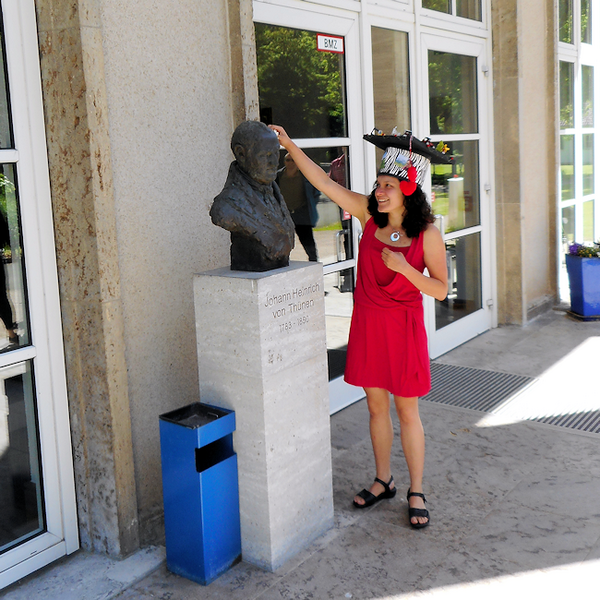Viridiana Alcántara Cervantes succesfully defended her doctoral thesis on May 31st, 2017 at the Faculty of Architecture, Civil Engineering and Environmental Sciences of the Technical University Braunschweig. The doctoral thesis was accomplished within the framework of the DFG project “Burial of soil organic matter for carbon sequestration in soils – potentials, processes and long-term effects”. Additional storage of soil carbon is widely acknowledged as a climate change mitigation option to reduce atmospheric CO2 concentrations. Research has so far focused on practices that enhance the carbon stocks only in the first centimetres of the soil. This dissertation assessed and confirmed the potential of soil organic matter burial at large soil depth through deep ploughing and medieval ridge-and-furrow cultivation in cropland and forest soils. This work contributed to the enhanced understanding of the long-term stabilization and storage of carbon in subsoils.
For this purpose, soil samples from 10 deep ploughed crop fields, 5 deep ploughed forests and 5 well preserved medieval ridge-and-furrow fields under forests were collected in Germany and Denmark for multiple analytical characterization. A deep ploughed plot was hereby compared to an adjacent non-deep ploughed plot. Within the ridge-and-furrow fields under forest, a reference position without buried topsoil material was identified in which no net soil accumulation or removal had occurred. At the sampling sites, carbon-rich topsoil material had been buried down to a depth of 90 cm.
The deep-ploughed cropland soils contained on average 42±18% more SOC than the reference plots down to 100 cm. In contrast, total SOC stocks in deep ploughed forest soils were not significantly higher than in their respective reference soils (103±11 and 105±9 Mg ha-1, respectively, p=0.2). However, SOC stocks in subsoils of deep ploughed plots were higher than in reference plots both under forest and under cropland. The ‘newly formed’ topsoil of the deep ploughed soils still contained less SOC than the reference topsoil, 14% and 37% under cropland and under forest, respectively. This was attributed to the slow SOC accumulation in deep ploughed forest topsoils, partly related to N limitation and acidic conditions.
Buried SOC stability was assessed through one-year incubation experiments, which enabled a comparison of SOC turnover in buried topsoil stripes and reference topsoils under standardized laboratory conditions eliminating possible temperature, oxygen or water limitations. On average, the fraction of mineralised SOC, was 32% lower in incubated buried than in reference topsoils. Sandy cropland buried topsoil stripes and reference topsoils had the lowest mineralisable SOC fraction (27±4 and 40±6 mg CO2-C g-1 SOC, respectively). Buried SOC was partly to fully preserved, most effectively in sandy cropland soils, but selective preservation of certain, most stabile SOC fractions and preferential decomposition of labile fractions, such as the commonly most easily decomposable free light fraction, could not explain SOC stability. Land use history of many of the studied sandy sites as heath was identified as an important aspect concerning SOC stabilisation.
In the second part of the thesis, the impact of medieval ridge and furrow cropland management on SOC in five forest soils of different texture was assessed. Continuous clockwise ploughing in rectangular fields moved topsoil from the outer part of strip-shaped fields towards the centre, thus forming a corrugated microtopography with peripheral furrows and central ridges. This tillage technique led to the burial of former topsoil under the ridges. SOC content was 0.4-0.9 g kg-1 higher at ridges than at reference positions, indicating long-term preservation of former topsoil SOC by burial under ridges, although enhanced SOC stocks at ridges due to carbon burial could not be significantly confirmed for all sites. Another important factor in these systems was the modified C input patterns in relation to the microtopography. Enhanced C input at furrows through leaf litter accumulation was indicated by higher SOC content in the free light fraction (10±5 and 6±3 g kg-1, respectively) and higher specific SOC mineralisation at furrows than at ridges (37±4 and 31±3 μg CO2-C g-1 SOC, respectively).
Viridiana Alcántara could draw from her doctoral thesis work the conclusion that deep ploughing led to enhanced subsoil SOC contents and stocks compared to a reference plot in forests and cropland. Deep ploughing increased the storage space for SOC by mechanically translocating topsoil material into the subsoil, where originally relatively less SOC is stored in most soil types. However, the establishment of new topsoil horizons that continue to accumulate SOC even more than four decades after deep ploughing additionally determine the effect of deep ploughing on full profile SOC stocks. Furthermore, deep ploughing may enhance the rooting depth and water storage capacity and thus provide less fluctuant stabilise plant growth conditions under climate change conditions. In forests on land with historical use of a ridge and furrow system, recent processes with spatial heterogeneous C input due to preserved microtopography determine SOC distribution, but not necessarily also SOC stocks. Buried topsoil could be detected even centuries after burial.

![[Translate to English:] [Translate to English:]](/media/_processed_/6/4/csm_titel_CO2Kampagne8_afeea2273e.png)
![[Translate to English:] [Translate to English:]](/media/_processed_/4/1/csm_titel_93px_CO2Kampagne8_9b0f3354d4.png)

![[Translate to English:] Logo des Bundesministerium für Ernährung und Landwirtschaft](/media/allgemein/logos/BMEL_Logo.svg)